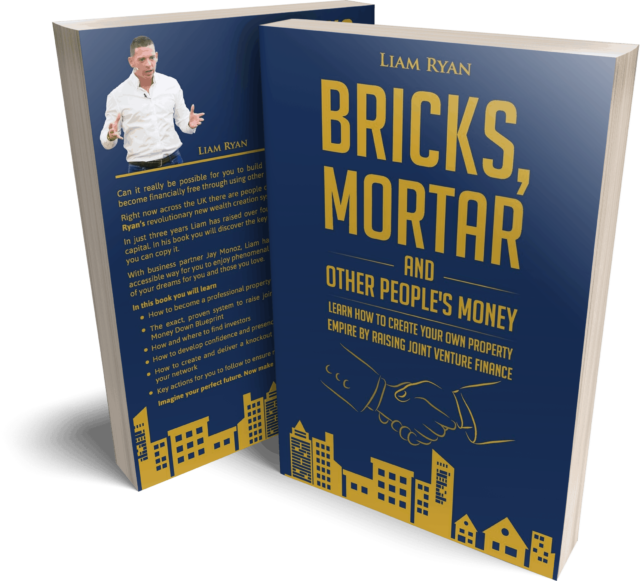Buy-to-Let vs. Buy-to-Flip: Choosing the Best UK Property Investment Strategy in 2025

The UK property market presents a variety of choices for the budding property investor, including the two popular strategies of buy-to-let and buy-to-flip. But which is the better choice that will offer you the best return on investment and suit your level of expertise and investment goals? Join me, Liam J Ryan, as I discuss these two investment strategies, their pros and cons, and help you make an informed choice depending on your investment goals.
Table of Contents
ToggleWhat is Buy-to-let?
Buy-to-let means purchasing a property to rent out to tenants and making a profit from your rental earnings. This is a popular long-term investment strategy that offers a steady income, also the property can appreciate in value over time.
What is Buy-to-flip?
Buy-to-flip, also known as flipping or buy-to-sell, means buying a property to renovate, thus increasing its value, and then selling it for a profit. This is a more risky investment strategy but is popular thanks to the potential for high profits within a relatively short time.
Is it Better to Buy-to-let or Flip? Pros and Cons
There are several benefits and drawbacks to buy-to-let and buy-to-flip – here are a few to consider before making a choice:
3 Pros of buy-to-let
- Generates a stable source of income. For those seeking steady returns, buy-to-let can be a good option.
- A long-term investment allows you to build up equity in the property over time as it appreciates in value and house prices continue to rise. You can also remortgage properties to release equity for further investments.
- Demand for rental properties is high. Thanks to the cost of living and high house prices, the rental market is stronger than ever, so finding tenants is fairly easy.
3 Cons of buy-to-let
- Additional responsibilities. If you have buy-to-let properties, you are now a landlord as well as an investor and are responsible for property management. Dealing with tenants, handling maintenance issues, and complying with rules and regulations takes time.
- Less return on your investment. Once the mortgage, insurance and maintenance costs are factored in, profits can be small.
- New legislation and existing laws can cut into your ROI. More stringent rental regulations can cost you a lot in additional renovations and maintenance that properties need to stay up to code and comply with regulations.
4 Pros of buy-to-flip
- High short-term profits. The goal when flipping a house is to buy at below-market value, renovate it efficiently, and then sell for a profit. This ideally has a quick turnaround time, offering you a fast return on your investment.
- Higher ROI than buy-to-let. If you find a gem of a property in a good location, you can make more profit than if you rented out a similar property.
- Fewer responsibilities. You don’t have to deal with tenants, landlord insurance, or other concerns when you are flipping a property, saving you time and money.
- More agility. Buy-to-flip investors can sell properties when the housing market is good, and hold off from selling when the market is poor without losing much money.
4 Cons of buy-to-flip
- Unforeseen expenses. A property that seems like a steal might require extensive renovations before it can be sold, reducing your ROI. You might need a bridging loan to cover repairs and refurbishments, cutting further into your potential profits.
- Project management. It takes time and effort to manage a successful management project, from obtaining permits to liaising with contractors.
- Lack of expertise. Property investors with little experience can make costly mistakes that cut into their ROI – getting the timing wrong can make all the difference, as buying a house when prices are high and then trying to sell for a profit when the market is low is a poor strategy for the uninformed investor.
- Higher tax rates. Profits from property sales can be subject to capital gains tax (unless you live in the property), as well as income tax if you are operating as an individual, or corporation tax if you are operating through a limited company.
Short-term and Long-term ROI
Both investment strategies offer different short and long-term outcomes for ROI. Buy-to-let offers a modest short-term ROI from rental income, once costs like mortgage payments and others have been covered. The property also can appreciate in value over time, and earn more money due to rental income growth and from the increased property value. This makes buy-to-let ideal for investors seeking steady, long-term returns.
Buy-to-flip has the potential for a high ROI, depending on how quickly and cheaply the renovation can be done, as well as the housing market at the time of selling. Buy-to-flip is inherently a short-term strategy, as the goal is to renovate and sell the house as quickly as possible, but repeated flips can accumulate significant profits over time.
Buy-to-Let vs. Buy-to-Flip in the UK Market (2024-2029 Predictions)
Rising House Prices
Despite a slight dip in UK house prices in early 2024, the market recovered quickly and property prices are rising as they have done for the past few decades. Predictions for the next 5 years indicate that this trend will continue, keeping the buy-to-let investment option lucrative as people may struggle to buy their own house and continue renting. Rising house prices could be a double-edged sword for potential buy-to-flip investments, with investors having to spend more on their initial investment, but could look forward to increased profits.
Upcoming General Election
The announcement of a general election in July 2024 and the possibility of a Labour government rather than a Conservative government could result in more aggressive wealth taxes, making buy-to-let and buy-to-flip investment strategies less profitable. Labour also promised to build 1.5 million more homes in the UK, which could affect house prices and the rental market, but time will tell if this will happen.
Mortgage Rates
Currently, the base rate set by the Bank of England is quite high at 5.25% in a bid to curb inflation, but it is predicted to drop modestly over the next 5 years, with an estimated rate of 3.57% in January 2029. This will affect the mortgage rate which is predicted to fall along with the base rate, and CBRE has published predictions that a 5-year fixed mortgage with a 75% LTV would be offered at a rate of 2.99% in Q4 of 2028. This could lower the initial investment required for both buy-to-let and buy-to-flip investments.
Sustainability Requirements
With growing environmental concerns and higher demand for sustainability in all industries, buyers are likely to demand more energy-efficient properties, which could impact the value of older, less efficient properties.
Factors to Consider When Choosing an Investment Strategy (buy-to-let and buy-to-flip)
Choosing between buy-to-let and buy-to-flip depends mainly on your level of experience and goals for investment. Here are some factors you should consider before making a decision:
Investment Goals
If you are looking for a low-risk investment that provides regular income with the potential for long-term growth, then buy-to-let could be a good choice for you. If you prefer a high-risk, high-reward investment and you have previous experience in renovation and property investment, then buy-to-flip may be ideal.
Time Commitment
If you are willing to spend some time managing your properties and dealing with tenants, then buy-to-let could be a good choice, if you would prefer a more short-term commitment without the responsibility of tenants, then buy-to-flip could work for you.
Financial Situation
Buy-to-let requires a lower initial investment than buy-to-flip, especially with properties that require a lot of renovation. Short-term loans for property renovation can carry higher interest rates and are unsecured, meaning that you could be in a more vulnerable financial situation than you want.
Want to learn more about different property investment strategies? Join me at one of Assets For Life’s FREE property events – click here to sign up.
You May Also Be Interested In...

Lodgers’ Agreements – Guide For Landlords
Learn how to create a lodger’s agreement, your legal rights, and responsibilities as a landlord

Property Investment Strategies with Martin Roberts
Discover top UK property investment strategies, including buy‑to‑let, renovations, and HMOs, plus tax and finance

Short-term Rentals – Are They Worth It For Investors?
Discover if short-term rentals are worth it for UK investors. Learn how to invest in
Featured Property Investment Events & Courses
The Property Deal Packaging Summit
The Property Millionaire Bootcamp
The Serviced Accommodation Bootcamp





